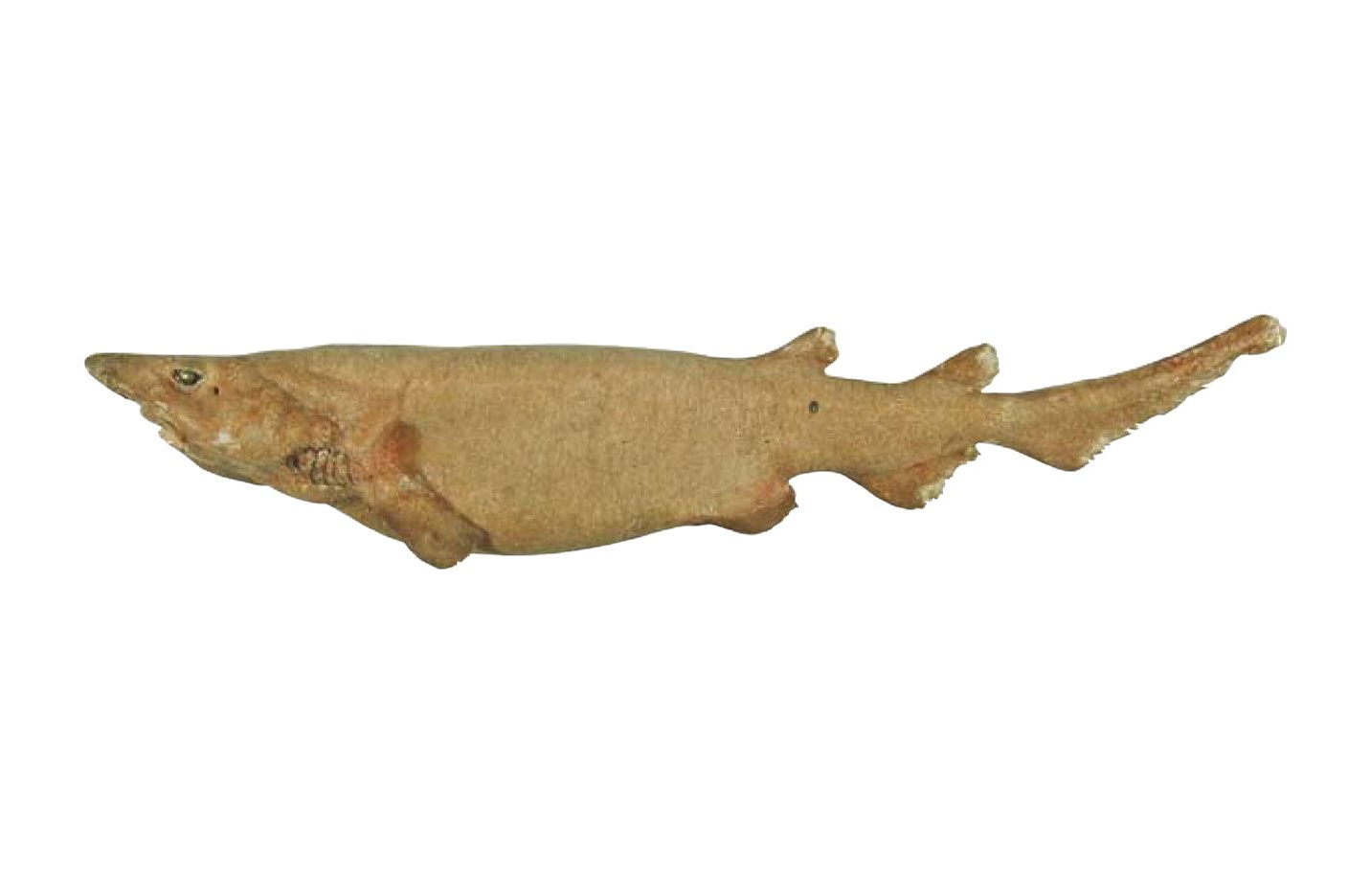Bighead Catshark, Apristurus bucephalus White, Last & Pogonoski 2008

Holotype of the Bighead Catshark, Apristurus bucephalus, female, CSIRO H 2615–01, 675 mm TL, fresh. Source: Fig. 1A, in White et al. (2008) CSIRO Marine and Atmospheric Research Paper No. 022: 105-111. License: CC by Attribution-NonCommercial-ShareAlike
Summary:
A uniformly medium yellowish-brown catshark with a few large, asymmetric, blackish spots on the body, a large, broad, robust head, a long pre-pectoral length, the upper labial furrow slightly shorter than the lower furrow, a triangular anal fin and sparsely distributed weakly tricuspid dermal denticles.
Cite this page as:
Bray, D.J. 2023, Apristurus bucephalus in Fishes of Australia, accessed 20 Apr 2024, https://fishesofaustralia.net.au/home/species/2616
Bighead Catshark, Apristurus bucephalus White, Last & Pogonoski 2008
More Info
|
Distribution |
Off Cape Leeuwin and Mandurah, Western Australia. |
|
Features |
Monospondylous vertebrae 35, diplospondylous precaudal vertebrae 26, total vertebrae ~ 108. Upper and lower labial furrows subequal in length; preorbital snout relatively short; head very robust, width (at mouth corners) 13.9% TL; mouth large, width 11.1% TL; orbit large, length 3.7% TL; prepectoral length and prepelvic length relatively long; first dorsal fin slightly smaller than second dorsal fin, originating well forward of pelvic-fin insertion; anal fin tall, short-based, triangular in shape; dermal denticles widely spaced, moderately large, deciduous, with long medial cusps; teeth in about 66 rows in upper jaw, about 55 rows in lower jaw; teeth of adult female with 5 cusps, 1 very long medial cusp, 2 much shorter inner lateral cusps, 2 much shorter outer lateral cusps situated anteriorly to inner lateral cusps. |
|
Colour |
Freshly-caught: upper and lower surfaces of body uniformly medium yellowish brown; fins similar in colour basally and slightly darker brown distally. A few large, asymmetric, blackish spots on body; one below first dorsal fin on left side, one on dorsal head at anterior of right orbit, one medial to right orbit and one near right pelvic-fin base. Tongue and palate dark brown. Pupils pale greenish yellow, iris black. |
|
Similar Species |
Differs from the Bulldog Catshark, Apristurus pinguis, in having widely spaced and somewhat elevated dermal denticles (vs. overlapping and more flattened denticles in A. pinguis). Differs from the similar Roughskin Catshark, A. ampliceps in a number of morphometric characters, including having a broadly triangular anal fin (vs. a distinctly rounded anal fin in A. ampliceps). |
|
Etymology |
The specific name bucephalus is from the Latin bu- (= large) and the Greek kephalis (= of the head) in allusion to the large, broad head of this species. |
|
Species Citation |
Apristurus bucephalus White, Last & Pogonoski 2008, CSIRO Marine and Atmospheric Research Paper No. 022: 106, Figs. 1-3. Type locality: West of Mandurah, Western Australia, 32°33'S, 114°25'E, depth 1030-1140 m. |
|
Author |
Bray, D.J. 2023 |
|
Resources |
Bighead Catshark, Apristurus bucephalus White, Last & Pogonoski 2008
References
Compagno, L.J.V., Dando, M. & Fowler, S. 2005. A Field Guide to the Sharks of the World. London : Collins 368 pp. (as Apristurus sp. F)
Last, P.R. & Stevens, J.D. 1994. Sharks and Rays of Australia. Canberra : CSIRO Australia 513 pp. 84 pls. (as Apristurus sp. F)
Last, P.R. & Stevens, J.D. 2009. Sharks and Rays of Australia. Collingwood : CSIRO Publishing Australia 2, 550 pp.
Lisney, T.J. & Cavanagh, R.D. 2015. Apristurus bucephalus. The IUCN Red List of Threatened Species 2015: e.T42703A68608866. https://dx.doi.org/10.2305/IUCN.UK.2015-4.RLTS.T42703A68608866.en. Accessed on 21 August 2023.
White, W.T., Last, P.R. & Pogonoski, J.J. 2008. Apristurus bucephalus sp. nov., a new deepwater catshark (Carcharhiniformes: Scyliorhinidae) from southwestern Australia. pp. 105-112 in Last, P.R., White, W.T. & Pogonoski, J.J. (eds). Descriptions of new Australian chondrichthyans. CSIRO Marine and Atmospheric Research Paper No. 022: 1-358 http://hdl.handle.net/102.100.100/118353?index=1


